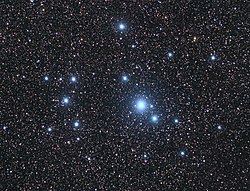IC 2602
This article may be expanded with text translated from the corresponding article in Italian. (January 2018) Click [show] for important translation instructions.
|
| IC 2602 | |
|---|---|
 | |
| Observation data (J2000 epoch) | |
| Constellation | Carina |
| Right ascension | 10h 42m 57.5s[1] |
| Declination | −64° 23′ 39″ |
| Distance | 547 ly[2] (167.7 pc) |
| Apparent magnitude (V) | 1.9[3] |
| Apparent dimensions (V) | 50′ × 50′ |
| Physical characteristics | |
| Estimated age | 13.7 M.yr−1 |
| Other designations | Theta Carinae Cluster, Caldwell 102, Cr 229, Mel 102, VDBH 103[2] |
IC 2602, generally known as the Southern Pleiades or Theta Carinae Cluster, is an open cluster in the constellation Carina that was discovered by Abbe Lacaille in 1751 from South Africa. Easily seen with the naked eye, this cluster is one of the closest to us, whose distance is about 167.7 parsecs (547 light-years) away from Earth.
The Southern Pleiades (IC 2602) has a total apparent magnitude of 1.9, which is 70% fainter than the Taurean Pleiades, and contains about seventy-four stars. It is the third-brightest open cluster in the sky, following the Hyades. Like its northern counterpart, the Southern Pleiades spans a sizeable area of sky, approximately 50 arcminutes, so it is best viewed with large binoculars or telescope with a wide-angle eyepiece.
θ Carinae is the brightest star within the open cluster, with the apparent visual magnitude of +2.74. p Carinae (PP Carinae) is another third-magnitude star known to be a member of IC 2602, although it lies well outside the main visible grouping of stars. All the other members the cluster are of the fifth magnitude and fainter, but several are naked-eye objects, including HR 4196 (V518 Car), , HR 4205, , , HR 4222, , , and .
IC 2602 is likely about the same age as the open cluster IC 2391,[4] which has a lithium depletion boundary age of 50 million years old,[5] though the accepted age from its HR-Diagram is about 13.7 million years.[6] IC 2602 stars are also all likely a part of the Lower Scorpius-Centaurus Association.[7][8]
References[]
- ^ "NED results for object IC 2602". National Aeronautics and Space Administration / Infrared Processing and Analysis Center. Retrieved 23 January 2017.
- ^ a b "IC 2602". SIMBAD. Centre de données astronomiques de Strasbourg.
- ^ "IC 2602 - SEDS Messier Database". Retrieved 23 January 2016.[permanent dead link]
- ^ Stauffer, J.R.; et al. (1997). "Rotational Velocities and Chromospheric/Coronal Activity of Low-Mass Stars in the Young Open Clusters IC 2391 and IC 2602". Astrophysical Journal. 479 (2): 776. Bibcode:1997ApJ...479..776S. doi:10.1086/303930.,
- ^ Barrado y Navascues, D; Stauffer, J.R.; Jayawardhana, R. (2002). "Spectroscopy of Very Low Mass Stars and Brown Dwarfs in IC 2391: Lithium Depletion and Hα Emission". Astrophysical Journal. 614 (1): 386–397. arXiv:astro-ph/0406436. Bibcode:2004ApJ...614..386B. doi:10.1086/423485.
- ^ "WEBDA page for open cluster IC 2602". WEBDA. Retrieved 2017-04-11.
- ^ Whiteoak, J.B. (1961). "A study of the galactic cluster IC 2602. I. A photoelectric and spectroscopic investigation". Monthly Notices of the Royal Astronomical Society. 123: 245–256. Bibcode:1961MNRAS.123..245W. doi:10.1093/mnras/123.3.245.
- ^ Blaauw, A. (1964). "The O Associations in the Solar Neighborhood". Annual Review of Astronomy and Astrophysics. 2: 213–246. Bibcode:1964ARA&A...2..213B. doi:10.1146/annurev.aa.02.090164.001241.
External links[]
| Wikimedia Commons has media related to IC 2602. |
Coordinates: ![]() 10h 42m 56s, −64° 23′ 42″
10h 42m 56s, −64° 23′ 42″
- IC 2602
- Carina (constellation)
- Open clusters
- Caldwell objects
- Astronomical objects discovered in 1751